If you’ve been shopping for an acoustic guitar, you’ve probably come across words like dreadnought or concert describing its shape, and there’s a good chance you weren’t quite sure what the difference between the two was.
In this KillerGuitarRigs Guide we’ll be taking a look at both of these popular acoustic guitar styles. We’ll talk about the pros and cons of each to help you decide which body shape is right for you, and we’ll even recommend a few models.
Keep reading as we learn more about dreadnought and concert acoustic guitars.
Contents
What is the Difference Between Dreadnought and Concert Acoustic Guitars?
So, what is the difference between concert and dreadnought guitars? The main difference between concert and dreadnought style acoustic guitars is the shape. Dreadnought bodies are large and broad with only a slight reduction in width from the lower bouts to the upper bouts at the guitar’s shoulders. Concert guitars, on the other hand, are much smaller, both in width and depth, and they also have a much more pronounced waist, giving the guitar more of an hourglass shape.
The differences aren’t limited to shape and size either. In fact the shape and size of these guitars play a big part in their volume and tone, too. We’ll go into more depth on the specifics later in the guide, but in summary, expect delicate and articulate tones with low to moderate volume from concert style guitars, and big, punchy tones with plenty of bottom end presence and huge volume from dreadnought bodied guitars.
Dreadnought Acoustic Guitar Guide
History
The dreadnought is, relatively speaking, one of the newer styles of acoustic guitar. It was designed and developed in 1916 by one of the biggest names in luthiery, C.F. Martin. Since then it has gone on to become one of the most popular shapes on the market, with virtually every acoustic guitar manufacturer making their own version of this style.
Tones
Dreadnought guitars became popular primarily due to their tonal properties. They offer a rich, and deep tonal palette with huge bass response, while simultaneously providing punchy mids and, depending on the tonewood used, a shimmering top end.
The secret to their tone lies in the shape and size of the soundboard, sometimes known as the top. By increasing the width of the waist and shoulders, the soundboard became larger, which enabled it to vibrate more freely. This ultimately boosts the bottom end, and dramatically improves sustain and volume.
Who Are Dreadnought Guitars Best For?
Dreadnoughts are actually some of the most versatile acoustic guitars, and because of this, they work with practically every genre. Because of their ability to punch through a mix, you’ll see them used in rock, blues, and country, and because they provide so much presence, they are loved by singer songwriters and bluegrass musicians, too.
Concert Acoustic Guitar Guide
History
The exact history of the concert guitars as we know it today isn’t quite as clearly defined as the dreadnought. They trace their lineage to the classical guitar, as evidenced by the almost identical body shape, but they feature a neck and bridge adapted for the high tension of steel strings.
Concert acoustics come in 2 sizes, standard concert, and grand concert. Grand concerts follow the same proportions, but are a little larger, which helps to improve projection and bass response.
Tones
Concert bodies are amongst the brightest sounding of all acoustic guitars. Their smaller soundboards, complete with narrow waists produce a tight mid range focus and a well defined tone. The reduced bass presence helps to prevent muddiness, especially in ensembles, which makes them popular as lead instruments in groups with multiple guitars.
Who Are Concert Guitars Best For?
Because of their small size, they are much more comfortable to hold than the average dreadnought. This has made concert style guitars very popular with smaller players who value ergonomics over volume.
Their bright tones and tight mids also make concert guitars ideal for fingerpicking and other arpeggiated styles of play, too. They can sometimes lack the power to keep up with a band while strumming, but they have no problem cutting through with single note runs.
Classic Examples
Dreadnoughts
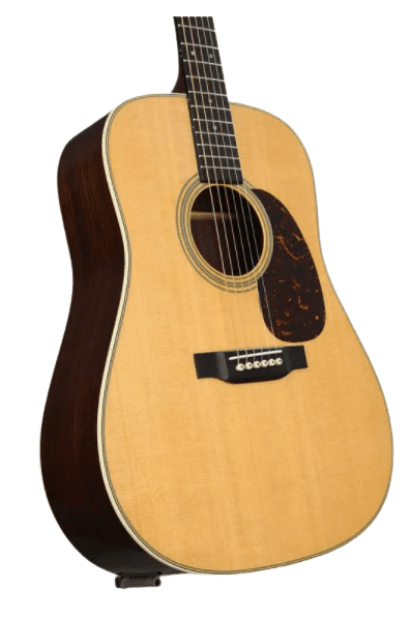
Martin D-28
The Martin D-28 is considered by many to be the industry standard dreadnought acoustic guitar. It can trace its roots back to Martin’s original 1916 design, and offers unparalleled pedigree. The tones are some of the finest you’ll get from any guitar, anywhere. It offers incredible balance, not only in the frequency range, but also between raw power and delicate nuance.
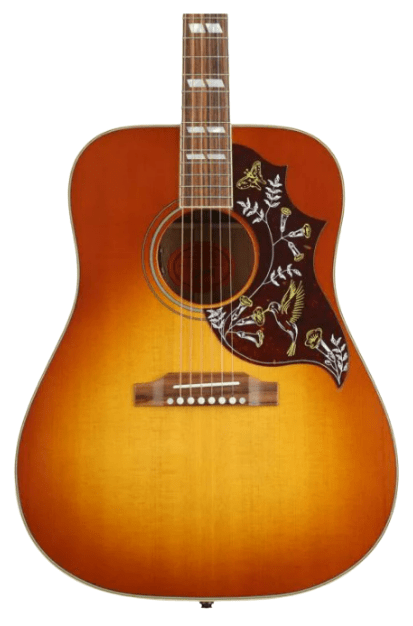
Gibson Hummingbird
The Gibson Hummingbird is a country classic. From the decorative scratch plate to the warm cherry sunburst finish, it looks absolutely incredible, and has tones to match. It’s without a doubt one of the most powerful acoustic guitars ever designed, with enormous volume and a huge bottom end that never, ever feels muddy. It’s a guitar that only gets better with age, and that’s why pros and serious musicians flock to the hummingbird.
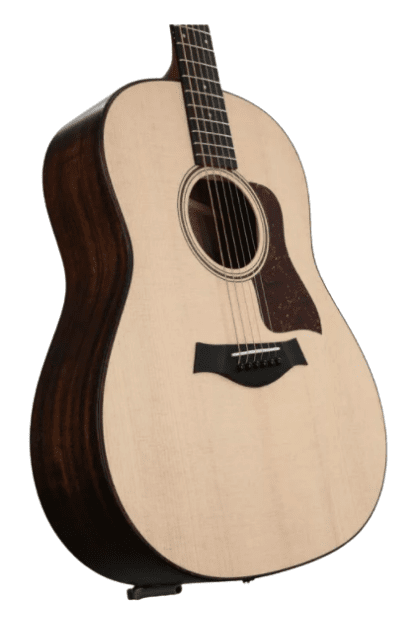
Taylor AD17
The Taylor AD17 is a slight variation on the standard dreadnought in that it has sloped shoulders, but regardless, it still offers all of the tone and projection of a standard dreadnought. This is one of Taylor’s entry level US made models, and relatively speaking, it offers incredible value for money. It’s made with all solid tone woods, and boasts an aged tone right out of the box.

Yamaha FG800
The Yamaha FG800 is one of the world’s best selling acoustic guitars, and for good reason. It features an all solid wood construction, and even features some attractive trim, including top and bottom binding on the body, and a stunning rosette. It boasts excellent playability, and an extremely rich tonal palette that has to be heard to be believed.
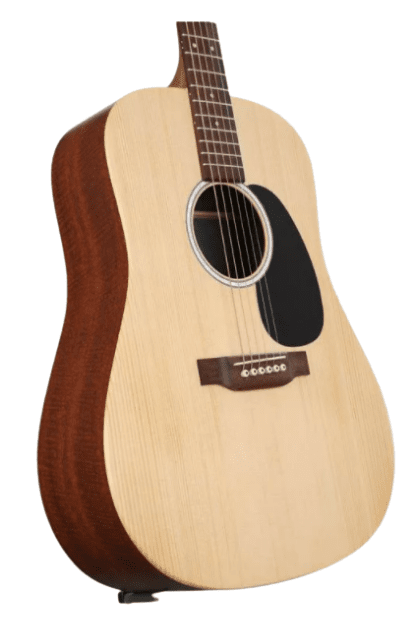
Martin D-X2E
From the brand that literally invented the dreadnought body shape comes this wonderful guitar, the Martin D-X2E. It offers a big, bold tone, with exceptional clarity and nuance, while still providing the big volume that the style is famous for. It’s built with exceptional attention to detail and high end components, including a solid sitka spruce top, and a select hardwood top with genuine mother of pearl inlay.
Concert
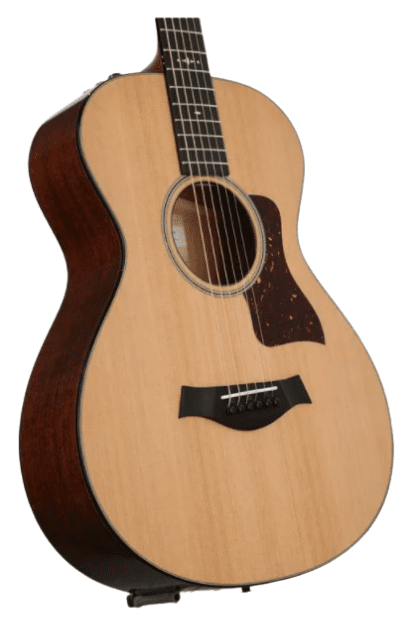
Taylor 512e
This is a professional level grand concert guitar that features the finest quality woods, and high end appointments throughout. It has a western red cedar top that adds an unmistakable warmth to the tone, with solid mahogany in use on the back and sides. The binding, fretboard, and bridge are all made from West African Ebony, and the slot head tuning machines in the open design headstock are some of the best on any guitar in the world. This is truly a world class guitar.
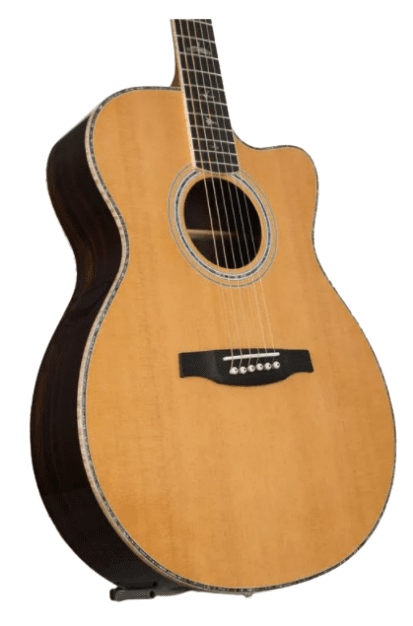
PRS SE Angelus A60E
This PRS SE Angelus A60E is a special looking guitar. At first glance you’ll notice the mother of pearl binding and rosette - they jump right off the guitar at you, and just scream quality. This is a cutaway model, so it brings excellent playability, and the solid Sitka spruce top keeps the top end incredibly bright. The back and sides are made of ziricote, which is a Central American hardwood that blends beautifully with the bright Sitka Spruce, providing superb balance to the tone.

Yamaha AC1M
As with the majority of Yamaha guitars, you’re getting way more than you’d expect for your money. The Yamaha AC1M includes a solid Sitka spruce top, a wood usually found on guitars twice its price, and solid mahogany back and sides. The result is a wonderful feeling guitar that plays with precision. Tones are strong through the mid and upper registers, but it still retains some rich bottom end from the Mahogany.

Taylor Academy 12
You’re getting exceptional value for money with this concert guitar from high end brand, Taylor. As part of their Academy line, you’ll note that there are no frills and fancy adornments on the Taylor Academy 12, but rather pure tone. It’s an exceptionally bright guitar, with incredible refinement and the best note separation you’ll find anywhere at this price point, hands down.
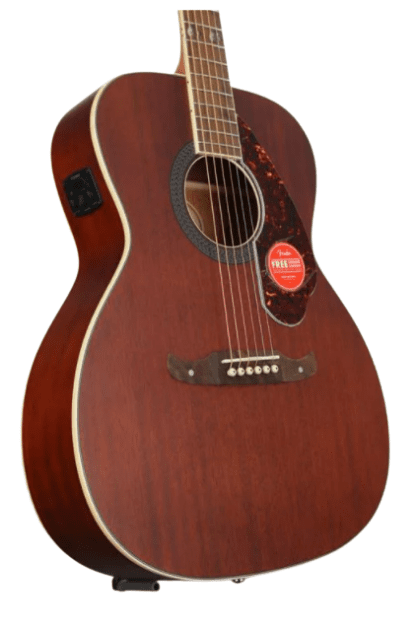
Fender Tim Armstrong Hellcat
The Fender Tim Armstrong Hellcat features all the attitude you’d expect of one of the founding members of the punk band, Rancid. It’s made to a high standard, as with most Fender models, and boasts a solid mahogany top. The walnut fretboard features unique Hellcat and skull inlay, which really helps this signature model to stand out in a crowd of similar looking guitars.
Best Dreadnought Acoustic Guitars
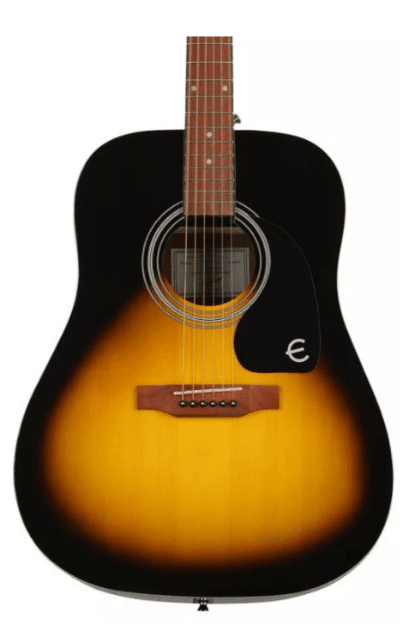
Epiphone DR-100
Incredible value with great tone and handsome looks.
With this Epiphone you’re getting classic dreadnought looks and performance. Considering the low price, it’s packed with great features, including a select spruce top, mahogany back and sides, and even a genuine rosewood fingerboard. This model is available in 3 finishes, and provides everything you need at a price to suit all wallets.
The sub $200 acoustic guitar market is saturated to say the least, but there are still some standout models that are worthy of your attention, including the Epiphone DR-100. This is a well made model from arguably the biggest brand in beginner to intermediate level guitars.
After unboxing, we were immediately impressed by the aesthetics. It looks (and feels like a much more expensive guitar than it really is. We received the vintage sunburst finish (our favorite), but it’s also available in Ebony, an all black finish, or, natural, in case you prefer your acoustics to have a more raw look.
It features a laminated spruce top, and laminated mahogany back and sides. Of course, a more high end model would have at least a solid wood top, but we didn’t find that it made an appreciable difference, at least to the casual player.
In fact, the all laminate construction makes this model much more durable than an equivalent that uses solid tone woods. Laminate is much more resistant to fluctuations in temperature and humidity, which makes it a great choice for younger players who might not be familiar with how to look after an acoustic guitar, or for somebody looking for a hard wearing campfire or beach guitar.
We found that the neck was exceptionally comfortable. It was made from solid mahogany, which was a nice touch, and had Epiphone’s SlimTaper profile, a shape that we’ve enjoyed on several of their models. We found no issue with the fret finishing either, and it even featured a rosewood fretboard which was quite incredible considering the extremely low cost.
We found that the out of the box setup, while not perfect, was still very good. It had a nice low action, and very little fret buzz. Intonation was accurate, and for a budget guitar, you can’t ask for much more than that!
As for the sound profile, it offered all the big, booming tone you’d expect from a full size dreadnought. It was bright and cheery, and it made for a great strummer. It didn’t have the biggest bass register, although we didn’t find that it was too thin either. The loss of bass is largely down to the laminate top not vibrating as freely as a solid equivalent wood top would.
Regardless, we still loved the sound, whether strumming or fingerpicking, this guitar plays like a much more expensive model – good news for anybody looking for a cheaper guitar that can hold up in a live setting.
Construction wise, we found it to be well made. The finish was nicely applied, and the hardware was all of good quality. The tuners weren’t high end, but still held tune well. Matching the rosewood fretboard was a lovely looking rosewood bridge. The saddle and nut were plastic, but they were well cut, and of course, if this was something you wanted to upgrade it’s very easily done.
Verdict: The Epiphone DR-100 is an excellent choice for the budget conscious dreadnought acoustic shopper. It gave us some great tones, and the sunburst finish looked great. It checked all of the boxes as far as build quality and reliability were concerned, and it will provide many years of use thanks to the rugged construction.
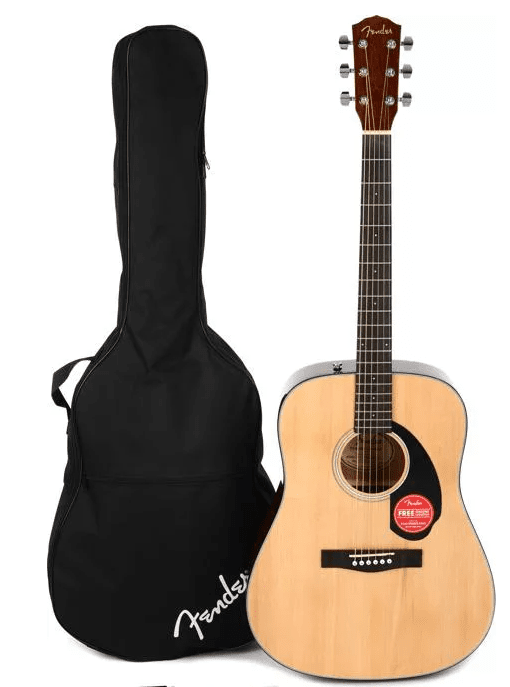
Fender CD-60S
A great looking guitar with excellent playability and solid tone woods.
If you’re looking for a turn key kit, this Fender should check all the boxes. The guitar itself is a gem, featuring a solid spruce top together with laminated mahogany back and sides, combining to form a durable and long lasting instrument with wonderful bright and punchy tones. Being a kit, it also comes with a quality gig bag, picks, a strap, and spare set of strings - everything you need to get playing right away.
The Fender CD-60S is a brilliant choice for players looking for a combination of performance and low price. You’re getting some features usually found on much more expensive models, a big name brand, and it even comes bundled with accessories.
As briefly mentioned, this guitar does come in a bundle, meaning you get a gig bag, picks, spare strings and even a strap included in the price. The guitar alone is a steal at the price, so to get these accessories included further increases the value.
Our test model came in a natural finish, it looked classic, and felt well made. It had a solid spruce top, a hallmark of some of the best acoustic guitars. At the back and sides laminate mahogany was used, which provided improved durability over something using solid wood for this part of the construction.
It featured a nato neck, which we really liked the feel of. Nato is a wood from the mahogany family, so performance wise there’s very little difference between nato and genuine mahogany, but it’s a much more sustainable choice, and it also costs a lot less.
The frets were mounted in a walnut fretboard, and we were impressed with the overall finish. The edges were smooth with no sprout, and we found that the rolled fretboard edges made it feel like a much more premium model.
It had excellent tonal balance, with a beefy bass response. It offered plenty of volume, and made for an outstanding solo artist instrument, although it still performed well in a mix. Up at the top end we got lots of bright and articulate shimmer, and we found that the mids were tight and punchy.
We found that the stock tuners were surprisingly good. They turned well with little to no play in the movement, and they kept the tuning stability holding strong, even with brand new strings. Intonation was good across the whole fretboard, and we found the nut and bridge to be well cut, and despite being plastic, weren’t detrimental to the tone.
The walnut bridge paired nicely with the walnut fretboard. We really liked the slightly lighter look of this wood compared to rosewood or mahogany. It performs similarly, but stands out in a sea of guitars that look very similar.
Verdict: The Fender CD-60S is a great choice for musicians of all levels looking for a quality dreadnought acoustic without breaking the bank. The solid spruce top provides the type of tones that have made the dreadnought so famous, and the stellar build quality will keep even the most demanding buyers happy.
Best Concert Acoustic Guitars
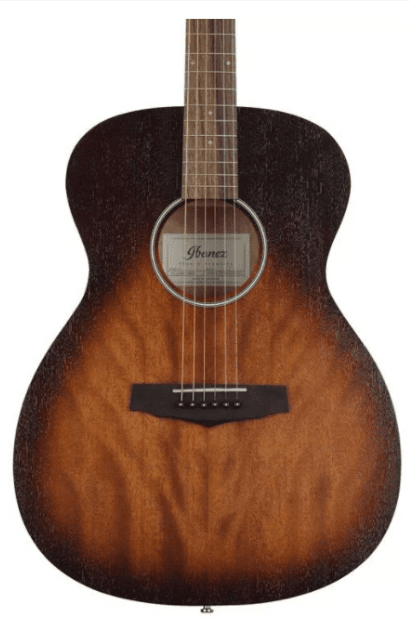
Ibanez PC19MH
Classic looks, bright tones, and quality construction.
Those looking for a fantastically well built concert guitar at an unbelievably low price should absolutely check out this Ibanez. It’s a hard-wearing instrument that makes the ideal starter acoustic. Featuring all laminate mahogany construction, the tones are rich and warm, while still maintaining the classic concert sparkle.
At the budget end of the concert shape category, the Ibanez PC19MH is incredibly hard to beat. It looks fantastic, it’s well made, and thanks to the choice of woods, has a much warmer, sweeter tone than the average concert guitar.
We were genuinely surprised at the overall look and feel of this guitar. It is one of the cheapest acoustics available from any major manufacturer, but regardless, it was really impressive. It had an open pore finish in mahogany sunburst which really made it stand out.
At first glance it looked just like a Martin Streetmaster, which is a definite plus point considering the Martin is almost 10 times the price.
Its neck was made of an unusual wood, nyatoh, which is an asian hardwood commonly used in budget guitars. Despite not being a premium wood, it still felt good. It was slim, although not as slim as a Wizard!
The fretwork was good, with no sharp edges, although the fret crowns were a little rough, which caused some scratching noises during play. This isn’t the biggest problem, however, as they’ll smooth out with use.
The tones were as tight as you’d expect from a concert body guitar. Lots of presence in the mid range, with some lovely top end shimmer, although the shimmer was actually mellowed a little by the full mahogany construction .
Construction quality was good overall. Considering the extremely low price, the hardware was actually quite good. It featured some lovely open gear tuners, which again, added to that Martin look. The tuners turned well without excess play, and tuning stability was rock solid.
We found no issues with intonation, and the factory setup was good. The action was a little higher than we usually like, but that is easily adjusted. The laurel fretboard felt good under the fingers, and didn’t suffer from excessive open pores like many others made with laurel do.
Verdict: Choosing a low cost guitar doesn’t have to mean you’re getting a low quality guitar, and that’s perfectly evidenced in the case of the Ibanez PC19MH. It’s a great looking instrument with killer tone and build quality that really far exceeds its incredibly reasonable price tag.
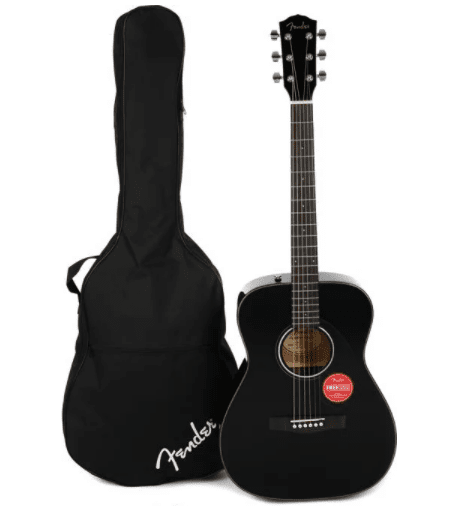
Fender CC-60S
Unbelievable value for money in this handsome, well equipped acoustic.
This is a fantastic acoustic bundle from famed brand, Fender. The guitar itself is a wonderful concert style instrument that offers incredible value for money. Built with a solid spruce top for superb resonance, and laminated mahogany back and sides for balance and durability, it offers all of the shimmering tones you’d expect from a quality concert body guitar.
The Fender CC-60S (full review here) represents incredible value for money. It’s loaded with features that you’d expect on much more expensive guitars, and the overall build quality and choice of materials is unbeatable in this price range.
This is another Fender bundle, so in the box you’re also getting a gig bag, strap, picks, and a set of genuine Fender spare strings. We found that the gig bag didn’t have the best padding, but it’s still protective enough to help you safely transport your guitar to and from lessons or jam sessions.
The tone wood choice is classic, with laminated mahogany back and sides and a solid spruce top. That top brings a fantastic top end, with good sustain and tons of sparkle. In the mids we found it was well focused and had good bite.
It played beautifully with softer styles like finger picking, and carried itself well while strumming.
It had a nato neck, which performed just like a traditional mahogany neck would. It was snappy and responsive, and the modern slim C profile was wonderfully comfortable. Aiding in the comfort of the neck were the rolled fretboard edges. They went a long way to reduce finger fatigue, and made the neck feel a lot faster.
As for its sound profile, we were really impressed with the overall balance. For a concert shape, it had a surprisingly full bottom end, which paired well with the strong mid range and treble presence.
It offered build quality equivalent to guitars 2 to 3 times its price, further proving how much value this instrument offers. The gloss black finish was beautifully applied and reached us without a scratch on it.
It had a walnut fretboard and a walnut bridge, both looked great, and the fingerboard in particular felt fantastic. The frets were well leveled, and the fret edges were smooth, without even a hint of sprout.
Tuning stability was a real strong point. The sealed die cast tuning machines did a great job of maintaining pitch, and turned well, always feeling as though the gear was properly engaged.
Verdict: It’s easy to see that the Fender CC-60S is a very well made guitar. We loved the well balanced tone, and the feel of the neck was far beyond anything we could have expected in the price range. It’s well made, and could easily handle casual gigging.
Final Thoughts on Concert vs. Dreadnought Acoustic Guitars
Ultimately, the decision on whether you should opt for a concert shape or a dreadnought is down to personal preference. It’s impossible to declare one better than the other because they offer such a distinctly different set of features that each appeals to a different set of guitarists.
If you’re a smaller player who finds large guitars hard to handle, a concert style will be easier to manage. If you’re a larger guitarist who wants high volume, consider a dreadnought. Players who tend to play softer music and more fingerstyle pieces will enjoy the clarity of the concert, while strummers who demand presence should consider dreadnoughts.
Check out these other articles you might like:


